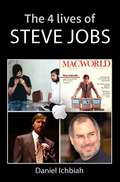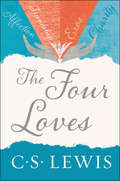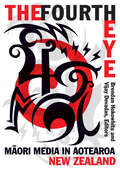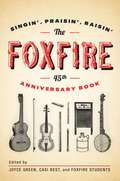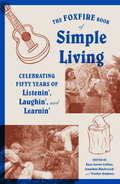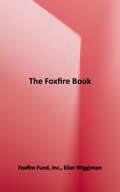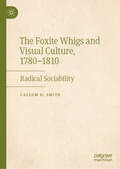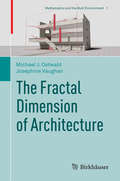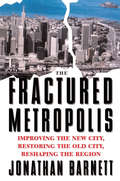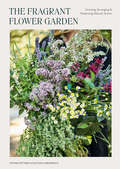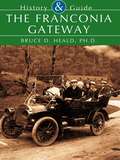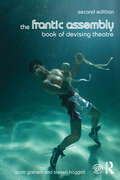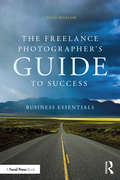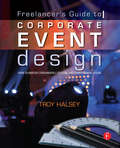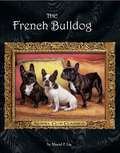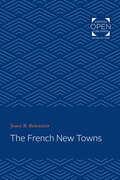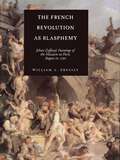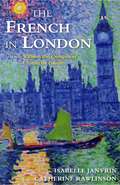- Table View
- List View
The Four Geniuses of the Battle of Britain: Watson-Watt, Henry Royce, Sydney Camm & RJ Mitchell
by David Coles Peter Sherrard"Had it not been for the vital contributions of the four men and their inventions described in this book the Battle of Britain could not have been won by the Royal Air Force. Each of these brilliant men contributed enormously to the aircraft and equipment upon which the gallant RAF fighter pilots depended to take on and defeat the hitherto overpowering Luftwaffe during Hitlers European onslaught. Watson Watt was the moving force behind Britains vital early warning radar network that allowed Allied fighter aircraft to intercept the incoming German bomber raids. Henry Royce was the driving force throughout the development of the Merlin engine that powered both the Hurricane and Spitfire.Sydney Camm persevered with the design of the Hawker Hurricane which was to destroy more Luftwaffe bombers in the Battle than any other type. It was amazingly resilient and provided an extremely stable gun platform. Never living long enough to see the success of his beautiful Spitfire, RJ Mitchell was the designer of the only British aircraft that could outperform the Nazi Bf 109s fighters and which allowed the attacking Hurricanes a little more safety while doing their job below. This is the story of those men behind the scene of the greatest air battle in history. "
The Four Lives of Steve Jobs: Steve Jobs biography
by Daniel IchbiahThe Four Lives of Steve Jobs Daniel Ichbiah No. 1 on the best-sellers list in August 2011 (French version). New edition updated in 2016 "So at thirty I was out. And very publicly out. What had been the focus of my entire adult life was gone, and it was devastating… …I didn't see it then, but it turned out that getting fired from Apple was the best thing that could have ever happened to me." This was Steve Jobs' confession on that morning in June 2005 to students at Stanford University. It summed up the growth that was slowly taking place in him. Chased out of Apple like scum in 1985, Jobs had made a resounding comeback ten years later and gave us devices that left a mark on their time, such as the iPod, iPhone and iPad. The world's most admired CEO, Steve Jobs mostly went against the tide, driven by a vision of genius and an extraordinary strength of conviction. However, he could also get it wrong: he was the one who nearly ruined Apple in 1984 after launching the Macintosh by insisting on poor technical choices! The 4 lives of Steve Jobs depicts Jobs' troubled youth, his rise to glory following the founding of Apple, his disgrace and his vain attempt at revenge followed by a return to the top. It also reveals a thousand unexpected facets of the extraordinary artist who ran Apple. * His quest for enlightenment in India * His initial refusal to recogniae the paternity of his daughter Lisa * His relationship with folk singer Joan Baez * The search for his mother, who abandoned him at birth * The attempt to treat his cancer with a vegetarian diet In his own way, Steve Jobs never stopped wanting to change the world, to change life... A best-seller Published by Leduc Editions in April 2011, the French version of The Four Lives of Steve Jobs was a number one best-seller at the end of August, 2011.
The Four Loves: An Anthology Of 8 C. S. Lewis Titles: Mere Christianity, The Screwtape Letters, The Great Divorce, The Problem Of Pain, Miracles, A Grief Observed, Abolition Of Man, And The Four Loves (C. S. Lewis Signature Classic Ser.)
by C. S. LewisA repackaged edition of the revered author's classic work that examines the four types of human love: affection, friendship, erotic love, and the love of God—part of the C. S. Lewis Signature Classics series.C.S. Lewis—the great British writer, scholar, lay theologian, broadcaster, Christian apologist, and bestselling author of Mere Christianity, The Screwtape Letters, The Great Divorce, The Chronicles of Narnia, and many other beloved classics—contemplates the essence of love and how it works in our daily lives in one of his most famous works of nonfiction. Lewis examines four varieties of human love: affection, the most basic form; friendship, the rarest and perhaps most insightful; Eros, passionate love; charity, the greatest and least selfish. Throughout this compassionate and reasoned study, he encourages readers to open themselves to all forms of love—the key to understanding that brings us closer to God.
The Fourth Eye: Maori Media in Aotearoa New Zealand (Indigenous Americas)
by Brendan Hokowhitu Vijay DevadasFrom the signing of the Treaty of Waitangi between Indigenous and settler cultures to the emergence of the first-ever state-funded Māori television network, New Zealand has been a hotbed of Indigenous concerns. Given its history of colonization, coping with biculturalism is central to New Zealand life. Much of this &“bicultural drama&” plays out in the media and is molded by an anxiety surrounding the ongoing struggle over citizenship rights that is seated within the politics of recognition. The Fourth Eye brings together Indigenous and non-Indigenous scholars to provide a critical and comprehensive account of the intricate and complex relationship between the media and Māori culture. Examining the Indigenous mediascape, The Fourth Eye shows how Māori filmmakers, actors, and media producers have depicted conflicts over citizenship rights and negotiated the representation of Indigenous people. From nineteenth-century Māori-language newspapers to contemporary Māori film and television, the contributors explore a variety of media forms including magazine cover stories, print advertisements, commercial images, and current Māori-language newspapers to illustrate the construction, expression, and production of indigeneity through media.Focusing on New Zealand as a case study, the authors address the broader question: what is Indigenous media? While engaging with distinct themes such as the misrepresentation of Māori people in the media, access of Indigenous communities to media technologies, and the use of media for activism, the essays in this much-needed new collection articulate an Indigenous media landscape that converses with issues that reach far beyond New Zealand. Contributors: Sue Abel, U of Auckland; Joost de Bruin, Victoria U of Wellington; Suzanne Duncan, U of Otago; Kevin Fisher, U of Otago; Allen Meek, Massey U; Lachy Paterson, U of Otago; Chris Prentice, U of Otago; Jay Scherer, U of Alberta; Jo Smith, Victoria U of Wellington; April Strickland; Stephen Turner, U of Auckland.
The Foxfire 45th Anniversary Book (Foxfire Series)
by Inc. Foxfire FundFor almost half a century, Foxfire has brought the philosophy of simple living to hundreds of thousands of readers, teaching creative self-sufficiency and preserving the stories, crafts, and customs of Appalachia. Inspiring and practical, this classic series has become an American institution. The Foxfire 45th Anniversary Book continues the beloved tradition of celebrating a simpler life, this time with a focus on Appalachian music, folk legends, and a history full of outsized personalities. We hear the encouraging life stories of banjo players, gospel singers, and bluegrass musicians who reminisce about their first time playing at the Grand Ole Opry; we shiver at the spine-tingling collection of tall tales, from ghosts born of long-ago crimes to rumors of giant catfish that lurk at the bottom of lakes and quarries; we recollect the Farm Family Program that sustained and educated Appalachian families for almost fifty years, through the Depression and beyond; and we learn the time-honored skills of those who came before, from building a sled to planting azaleas and braiding a leather bull-whip. Full of spirited narrative accounts and enduring knowledge, The Foxfire 45th Anniversary Book is a piece of living history from a fascinating American culture.From the Trade Paperback edition.
The Foxfire Book of Simple Living: Celebrating Fifty Years of Listenin', Laughin', and Learnin'
by Inc. Foxfire FundFirst published in 1972, The Foxfire Book was a surprise bestseller that brought Appalachia's philosophy of simple living to hundreds of thousands of readers. Whether you wanted to hunt game, bake the old-fashioned way, or learn the art of successful moonshining, The Foxfire Museum and Heritage Center had a contact who could teach you how with clear, step-by-step instructions. Today, Foxfire's mission remains the same, and The Foxfire Book of Simple Living is both a rich look back at five decades of collected wisdom, as well as an intriguing look forward at the artists and craftsman who are working to preserve the Appalachian tradition for future generations. We hear from doll and soap makers who continue to use and adapt the time-tested methods outlined in The Foxfire Book, not to mention hunters, blacksmiths, musicians, and carpenters whose respect for those who preceded them enhances their own art. We see how the mountain community has responded to the films, books, and plays that have tried (and sometimes failed) to represent them. And, above all, by listening to the voices of those who came before, we celebrate the people who have preserved the stories, crafts, and customs that define life in the Appalachian mountain region.
The Foxfire Book: Hog Dressing, Log Cabin Building, Mountain Crafts and Foods, Planting by the Signs, Snake Lore, Hunting Tales, Faith Healing, Moonshining, and Other Affairs of Plain Living
by Inc. Foxfire FundFirst published in 1972, The Foxfire Book was a surprise bestseller that brought Appalachia's philosophy of simple living to hundreds of thousands of readers. Whether you wanted to hunt game, bake the old-fashioned way, or learn the art of successful moonshining, The Foxfire Museum and Heritage Center had a contact who could teach you how with clear, step-by-step instructions. This classic debut volume of the acclaimed series covers a diverse array of crafts and practical skills, including log cabin building, hog dressing, basket making, cooking, fence making, crop planting, hunting, and moonshining, as well as a look at the history of local traditions like snake lore and faith healing.
The Foxite Whigs and Visual Culture, 1780-1810: Radical Sociability
by Callum D. SmithThis book offers a comprehensive exploration of the intricate relationship between radicalism and sociability in late Georgian parliamentary and extra-parliamentary politics, focusing on the Foxite-Whig faction. Re-evaluating the significance and tactical use of sociability and radicalism in late eighteenth and early nineteenth-century British politics, the book charts not only the rise and fall of a leading and neglected British political faction, but through its interdisciplinary and thematic focus, it seeks to intervene in the field and situate sociability as a key driver and facilitator of late Georgian politics. By utilising original research into contemporary newspapers, letters, diaries, legal records, parliamentary accounts, and especially political caricature, the author offers a new methodological approach in the study of sociability and radicalism and presents original categorisations of contemporary sociability. The book examines how sociability was strategically employed by the Foxite-Whigs and argues for the existence of two primary forms of sociability: insular and porous. Insular sociability manifested itself through dining, drinking to excess, or gambling in a private setting with members of the same aristocratic or political order. Porous sociability however was the extra-parliamentary mechanism by which Fox and his faction tactically opened their insular Whig World to forge connections with the lower orders, French revolutionary leaders, popular radicals, and Irish rebels. The author provides a detailed analysis of Foxite sociability within the context of distinct radical themes, including plebeian radicalism, French Revolutionary radicalism, and Irish radicalism. Beyond its innovative methodological approach to sociability studies, the book foregrounds visual culture as a lens through which to study and enter the &‘wordless experience&’ of the eighteenth century and to view the themes of sociability and radicalism from &‘within.&’ In doing so, the it reveals the inconsequential or informal dynamics of the Foxites&’ political and extra-parliamentary career from their origin in c.1780, to their decline in the early nineteenth century.
The Fractal Dimension of Architecture
by Michael J. Ostwald Josephine VaughanFractal analysis is a method for measuring, analysing and comparing the formal or geometric properties of complex objects. In this book it is used to investigate eighty-five buildings that have been designed by some of the twentieth-century's most respected and celebrated architects. Including designs by Le Corbusier, Eileen Gray, Frank Lloyd Wright, Robert Venturi, Frank Gehry, Peter Eisenman, Richard Meier and Kazuyo Sejima amongst others, this book uses mathematics to analyse arguments and theories about some of the world's most famous designs. Starting with 625 reconstructed architectural plans and elevations, and including more than 200 specially prepared views of famous buildings, this book presents the results of the largest mathematical study ever undertaken into architectural design and the largest single application of fractal analysis presented in any field. The data derived from this study is used to test three overarching hypotheses about social, stylistic and personal trends in design, along with five celebrated arguments about twentieth-century architecture. Through this process the book offers a unique mathematical insight into the history and theory of design.
The Fractured Metropolis: Improving The New City, Restoring The Old City, Reshaping The Region
by Jonathan BarnettTargeted at architects, students, urban designers and planners, landscape architects, and city and regional officials, The Fractured Metropolis provides a thorough analysis of not only cities but also the entire metropolitan region, considering how both are intrinsically linked and influence one other.
The Fragmented Politics of Urban Preservation: Beijing, Chicago, and Paris (Globalization and Community)
by Yue ZhangWhile urban preservation is almost as old as cities themselves, it has become increasingly controversial in modern cities. In this book, Yue Zhang presents a cross-national comparative analysis of the politics of urban preservation. Based on comprehensive archival research and more than two hundred in-depth interviews in Beijing, Chicago, and Paris, Zhang finds that urban preservation provides a tool for diverse political and social actors to frame their propositions and advance their favored courses of action. In cities from West to East, divergent political and economic interests have caused urban preservation to become contested. Exploring three of the world&’s great cities, Zhang deftly navigates readers through each case study, illustrating the complexities of the politics of urban preservation in each city. In Beijing, urban preservation was integral to promoting economic growth and enhancing the city&’s image during the lead-up to the 2008 Olympics; in Chicago, it is used to increase property values and revitalize neighborhoods; and in Paris, it offers a channel for national and municipal governments to compete for control over urban space. Although urban preservation serves various purposes in these cities, Zhang explains how different types of political fragmentation have affected the implementation of preservation initiatives in predictable ways, thus generating distinct patterns of urban preservation. A comparative urban politics study of unusual breadth, The Fragmented Politics of Urban Preservation gives us insight into the complex policy process of urban preservation through which political institutions are intertwined with interests and inclinations, fundamentally shaping the direction of urban development, the physical forms of cities, and the lives of citizens.
The Fragrant Flower Garden: Growing, Arranging & Preserving Natural Scents
by Stefani Bittner Alethea HarampolisMake your garden and home look and smell heavenly with this accessible gardening guide that explains how to grow fragrant flowers outdoors and bring natural scents indoors by creating floral arrangements, scented beauty products, and more.&“A practical guide to a life infused with the scent of flowers.&”—Kelly Smith Trimble, senior editorial director for HGTV and author of Vegetable Gardening Wisdom and The Creative Vegetable GardenerThere is nothing like the beauty and scent of a flower-filled garden and home. The Fragrant Flower Garden shows you how to grow flowers that are a feast for the nose as well as the eyes, from a naturally perfumed carpet of sweet alyssum and the warm, spicy scent of gardenia to the heavenly aroma of lilacs. A beautiful garden is one where you can find joy in every sense—literally. The Fragrant Flower Garden makes this dream a reality with garden design guidance for a year&’s worth of flowers, foliage, and fragrance. Then, reap the wellness benefits of your fragrant flowers through DIY projects such as making floral arrangements, perfumes, tub soaks, and tinctures.Whether you prefer the smell of classic lavender or something more adventurous like chocolate cosmos, The Fragrant Flower Garden opens the door to creating a scented flower garden that is a delight for all.
The Frame in Classical Art
by Verity Platt Michael SquireThe frames of classical art are often seen as marginal to the images that they surround. Traditional art history has tended to view framing devices as supplementary 'ornaments'. Likewise, classical archaeologists have often treated them as tools for taxonomic analysis. This book not only argues for the integral role of framing within Graeco-Roman art, but also explores the relationship between the frames of classical antiquity and those of more modern art and aesthetics. Contributors combine close formal analysis with more theoretical approaches: chapters examine framing devices across multiple media (including vase and fresco painting, relief and free-standing sculpture, mosaics, manuscripts and inscriptions), structuring analysis around the themes of 'framing pictorial space', 'framing bodies', 'framing the sacred' and 'framing texts'. The result is a new cultural history of framing - one that probes the sophisticated and playful ways in which frames could support, delimit, shape and even interrogate the images contained within.
The Frame-Up
by Ian Schoenherr Wendy McLeod MacKnightWhen Sargent Singer discovers that the paintings in his father’s gallery are alive, he is pulled into a captivating world behind the frame that he never knew existed.Filled with shady characters, devious plots, and a grand art heist, this inventive mystery-adventure celebrates art and artists and is perfect for fans of Night at the Museum and Blue Balliett’s Chasing Vermeer. There’s one important rule at the Beaverbrook Gallery—don’t let anyone know the paintings are alive. Mona Dunn, forever frozen at thirteen when her portrait was painted by William Orpen, has just broken that rule. Luckily twelve-year-old Sargent Singer, an aspiring artist himself, is more interested in learning about the vast and intriguing world behind the frame than he is in sharing her secret.And when Mona and Sargent suspect shady dealings are happening behind the scenes at the gallery, they set out to find the culprit. They must find a way to save the gallery—and each other—before they are lost forever. With an imaginative setting, lots of intrigue, and a thoroughly engaging cast of characters, The Frame-Up will captivate readers of Jacqueline West’s The Books of Elsewhere.
The Franconia Gateway
by Bruce D. HealdOf the several entrances to the White Mountains, none is more majestic than the Franconia Gateway. The gateway begins in the valley of the Pemigewasset River and reaches through broad meadows, between jagged mountains, alongside quiet pools and cascades of sparkling water, into the wilderness of Franconia Notch and beyond. Altogether, this region contains more historical secrets and hidden treasures than any other part of the White Mountains.The Franconia Gateway opens the way from a new perspective. With nearly one hundred fifty breathtaking views and fascinating stories, this history and guide leads from lore of the Native Americans, explorers, and early entrepreneurs to the logging boom years and the subsequent preservation era on to the days of the artists and poets and, ultimately, the tourists. The journey progresses through the communities of Plymouth, Campton, Thornton, Waterville Valley, Woodstock, and Franconia, and includes all the wonder and mystery of sites such as the Lost River, the Flume, and the Old Man of the Mountain.
The Frantic Assembly Book of Devising Theatre: Book Of Devising Theatre
by Scott Graham Steven Hoggett'This is a close companion to Frantic Assembly's practice and one that is written with an open and engaging, even disarming, tone ... A rich, rewarding and compelling text.' Stuart Andrews, University of Surrey As Frantic Assembly move into their twentieth year of producing innovative and adventurous theatre, this new edition of their well-loved book demystifies the process of devising theatre in an unusually candid way. Artistic directors Scott Graham and Steven Hoggett offer an intimate and invaluable insight into their evolution and success, in the hope that sharing their experiences of devising theatre will encourage and inspire students and fellow practitioners. The Frantic Assembly Book of Devising Theatre is a uniquely personal account of the history and practice of this remarkable company, and includes: · practical exercises · essays on devising, writing and choreography · suggestions for scene development · a 16-page colour section, and illustrations throughout · a companion website featuring clips of rehearsals and performances. This is an accessible, educational and indispensable introduction to the working processes of Frantic Assembly, whose playful, intelligent and dynamic productions continue to be acclaimed by audiences and critics alike.
The Freak-garde: Extraordinary Bodies and Revolutionary Art in America
by Robin BlynSince the 1890s, American artists have employed the arts of the freak show to envision radically different ways of being. The result is a rich avant-garde tradition that critiques and challenges capitalism from within. The Freak-garde traces the arts of the freak show from P. T. Barnum to Matthew Barney and demonstrates how a form of mass culture entertainment became the basis for a distinctly American avant-garde tradition. Exploring a wide range of writers, filmmakers, photographers, and artists who have appropriated the arts of the freak show, Robin Blyn exposes the disturbing power of human curiosities and the desires they unleash. Through a series of incisive and often startling readings, Blyn reveals how such figures as Mark Twain, Djuna Barnes, Tod Browning, Lon Chaney, Nathanael West, and Diane Arbus use these desires to propose alternatives to the autonomous and repressed subject of liberal capitalism. Blyn explains how, rather than grounding revolutionary subjectivities in imaginary realms innocent of capitalism, freak-garde works manufacture new subjectivities by exploiting potentials inherent to capitalism. Defying conventional wisdom, The Freak-garde ultimately argues that postmodernism is not the death of the avant-garde but the inheritor of a vital and generative legacy. In doing so, the book establishes innovative approaches to American avant-garde practices and embodiment and lays the foundation for a more nuanced understanding of the disruptive potential of art under capitalism.
The Freelance Photographer’s Guide To Success: Business Essentials
by Todd BigelowGrounded in real-life experiences and scenarios, this practical guide offers editorial, non-profit, foundation, and corporate photographers an honest and insightful approach to running a freelance photography business. Pulling from thirty years of experience as a freelance photographer, veteran Todd Bigelow presents a timely and detailed account of the methods and tactics best used to navigate and succeed in the profession. He explores the topics that define the business of freelancing, including: analyzing photography contracts; creating and maintaining an image archive; licensing for revenue; client development; registering for copyright; combating copyright infringement; and understanding tax issues, freelance business structures, and more. Chapters feature examples of real contract clauses and emails to better prepare readers for the practical daily activities that are essential to growing a success business. Likewise, Bigelow shares conversational anecdotes throughout to provide real insight into the world of freelancing. Based on the author’s sought-after Business of Photography Workshop, this book is an essential guide for emerging, mid-career, and experienced photographers interested in starting or improving their own freelance business.
The Freelancer's Guide to Corporate Event Design: From Technology Fundamentals To Scenic And Environmental Design
by Troy HalseyFreelancer's Guide to Corporate Theatre and Event Production (tentative title) will bring you up to speed on the ever changing and growing industry of Corporate Theatre. Written by one of the industry's leading designers, this book uses a candid and straight-forward style to guide you through the process of designing a successful event. Learn the fundamentals of venue selection, rigging, lighting, audio, video, and scenic design with informative diagrams and detailed illustrations. With the help of this book you will learn how to plan, design, and execute events of any size. Additionally, you will be armed with a strong knowledge of common mistakes, tips and tricks, and industry standards that will allow you to build and train a production team prepared for just about anything.
The French Bulldog
by Muriel P. LeeThe first title in the exciting new Kennel Club Classics series is French Bulldog, an elaborate photographic celebration of one of the dog world's most beloved breeds. Written and compiled by Just Frenchies editor Muriel P. Lee, this 200-page hardcover volume features articles on the breed's history by Anne M. Hier, breed health by Janice Grebe, judging by Virginia Rowland, the breed in England and France by Penny Rankine-Parsons, the breed in Australia and New Zealand by Michael Rosser, and working dogs by Bette and Manda Kaplan. No Frenchie lover will live without this volume on their coffee table!
The French New Towns (Johns Hopkins Studies in Urban Affairs)
by James M. RubensteinOriginally published in 1978. At the time this book was published, new towns were cropping up as a matter of public policy in "advanced industrial countries," yet the United States abandoned this project and deemed new towns "inappropriate and impractical for the American situation." The purpose of this book is to inform planners and policy makers around the world about French new towns. It analyzes what French new towns tried to accomplish; the administrative, financial, and political reforms needed to secure implementation of the program; and the achievements of the new towns. The author's evaluation of French new towns is undertaken with an eye to international applicability.In the United States, new towns have been proposed as a means for integrating low-income families into suburbs that are otherwise closed to them. The French experience demonstrates that socially heterogeneous new communities can be developed, even within the framework of a market system, if a sufficiently high priority is placed on the effort.
The French Revolution as Blasphemy: Johan Zoffany's Paintings of the Massacre at Paris, August 10, 1792 (The Discovery Series #6)
by William L. PresslyWilliam Pressly presents for the first time a close analysis of two important, neglected paintings, arguing that they are among the most extraordinary works of art devoted to the French Revolution. Johan Zoffany's Plundering the King's Cellar at Paris, August 10, 1792, and Celebrating over the Bodies of the Swiss Soldiers, both painted in about 1794, represent events that helped turn the English against the Revolution.Pressly places both paintings in their historical context—a time of heightened anti-French hysteria—and relates them to pictorial conventions: contemporary history painting, the depiction of urban mobs in satiric and festival imagery, and Hogarth's humorous presentation of modern moral subjects, all of which Zoffany adopted and reinvented for his own purposes. Pressly relates the paintings to Zoffany's status as a German-born Catholic living in Protestant England and to Zoffany's vision of revolutionary justice and the role played by the sansculottes, women, and blacks. He also examines the religious dimension in Zoffany's paintings, showing how they broke new ground by conveying Christian themes in a radically new format.Art historians will find Pressly's book of immense value, as will cultural historians interested in religion, gender, and race.
The French in London: From William the Conqueror to Charles de Gaulle
by Emily Read Isabelle Janvrin Catherine RawlinsonEver since 1066 there has been a substantial French presence in London. It is now said to be the sixth most populous French city and this book illustrates, explains, and exposes how this came about over more than a 1000 years. Full of individual stories and overlooked details covering a common history, from William the Conqueror to Charles de Gaulle.
The Fresh Prince Project: How the Fresh Prince of Bel-Air Remixed America
by Chris PalmerA &“thorough, thoughtful, and immensely entertaining&” (Jemele Hill, author of Uphill) cultural history of the beloved nineties sitcom that launched Will Smith to superstardom—The Fresh Prince of Bel-Air—in the vein of Seinfeldia and Best Wishes, Warmest Regards.More than thirty years have passed since The Fresh Prince of Bel-Air premiered on NBC but unlike other family sitcoms of its era, it has remained culturally relevant and beloved by new generations of fans. With fresh eyes on the show in the wake of 2022&’s launch of Bel-Air, a Fresh Prince reboot on NBC&’s Peacock, The Fresh Prince Project brings us never-before-told stories based on exclusive interviews with the show&’s cast, creators, writers, and crew. The Fresh Prince Project is an eye-opening exploration and celebration of a show that not only made Will Smith a household name but helped redefine America&’s understandings of race, sex, parenthood, and class.
The Freshman: Comedy and Masculinity in 1920s Film and Youth Culture (Cinema and Youth Cultures)
by Christina G. PetersenBefore the advent of the teenager in the 1940s and the teenpic in the 1950s, The Freshman (Taylor and Newmeyer, 1925) represented 1920s college youth culture as an exclusive world of leisure to a mass audience. Starring popular slapstick comedian Harold Lloyd, The Freshman was a hit with audiences for its parody of contemporary conceptions of university life as an orgy of proms and football games, becoming the highest grossing comedy feature of the silent era. This book examines The Freshman from a number of perspectives, with a focus on the social, economic, and political context that led to the rise of campus culture as a distinct subculture and popular mass culture in 1920s America; Lloyd’s use of slapstick to represent an embodied, youthful middle-class masculinity; and the film’s self-reflexive exploration of the conflict between individuality and conformity as an early entry in the youth film genre.

